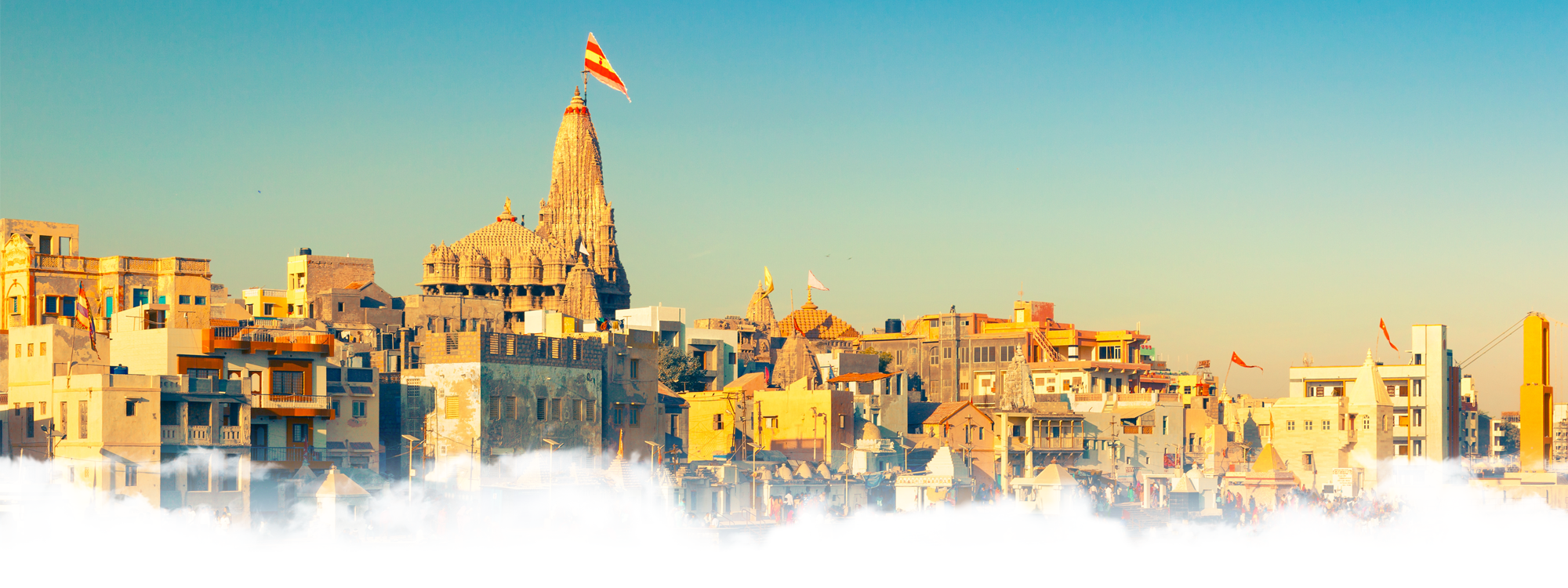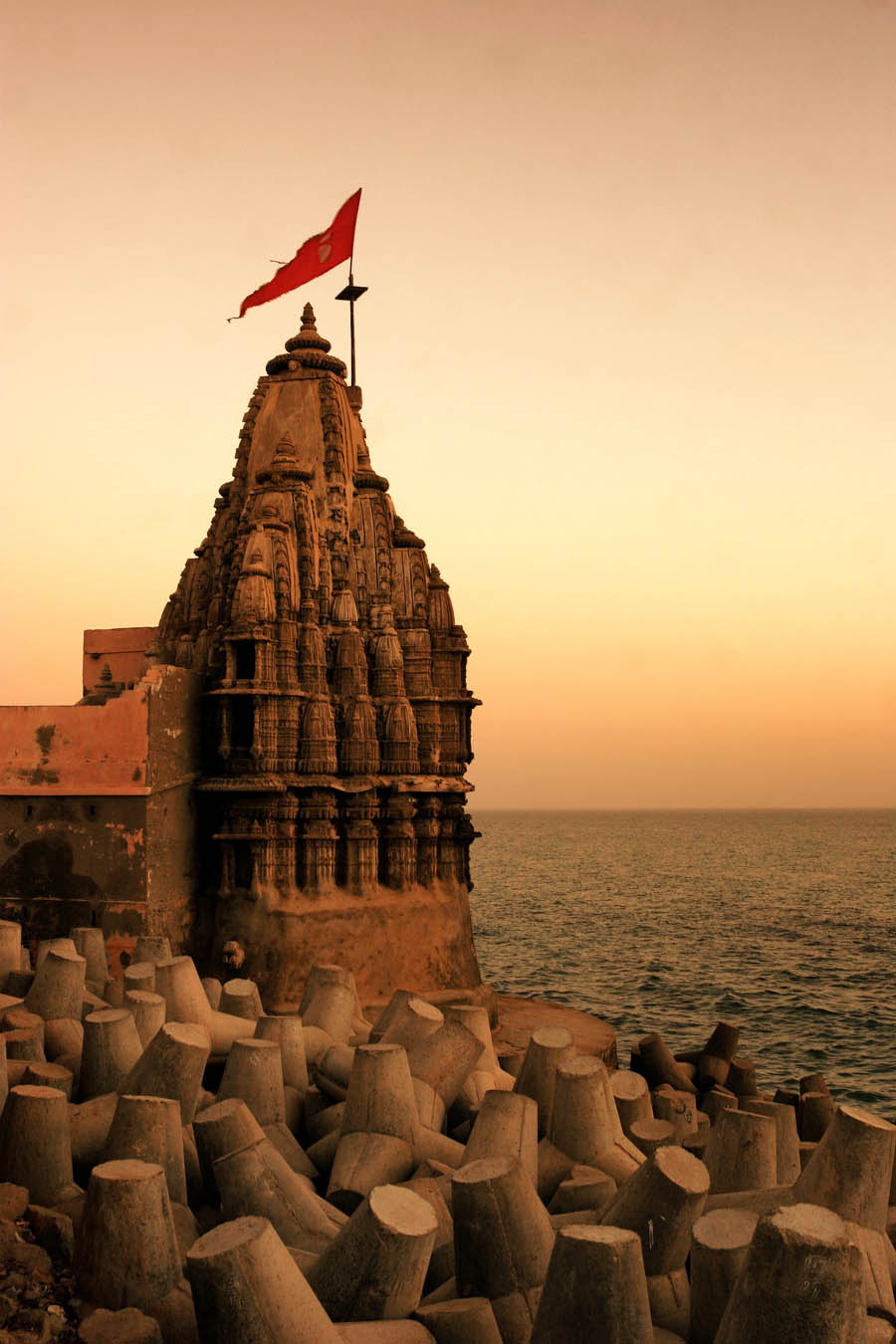
Dwarkadheesh Temple
Located in the glorious kingdom of Lord Krishna, the Dwarka temple, also known as the Dwarkadheesh Temple is one of the many houses of divinity.
History Behind the Temple
The Dwarka temple is one of the four Char Dham shrines that have immense religious importance to Hindu devotees.
Built with soft sandstone and sand, the temple has withstood the perils of time, preserving the unique cultural heritage of Dwarka over centuries. The temple has a unique blend of Nagara and Dravidian architectural elements owing to its Chalukyan style of architecture. Its teeming Shikhara and colossal flag bear great symbolic importance to Hindu tradition and culture.
Standing proudly at the bank of Gomati, the marvelous temple houses the shrines of Lord Krishna, Balarama, Subhadra, Rukmini, and many other deities or influential mythological figures.
The present structure of the temple was built in the 15th-16th century by Raja Jagat Singh Rathore. However archaeological evidence suggests that the current structure was built on the site of a pre-existing temple. As per Hindu religious texts, the old temple was built by Sri Krishna’s great-grandson Vajranabha on the site of Krishna’s royal Dwarka palace some 2000 years ago.

The Birth of the Temple
The origin of the Dwarkadheesh temple starts after Lord Krishna defeats his evil uncle Kans. Krishna left Mathura with the entire Yadava community. He built a beautiful town on the banks of Gomati River and named it ‘Swarnadwarika’.
Lord Krishna lived in the royal palace of Dwarka which was engulfed by the sea along with Dwarka city. Generations later, his great-grandson Vajranabha built the temple called Dwarkanatha in the devotion of Lord Krishna. Many believe that Vajranabha erected the temple in one night with the help of a mysterious force.
According to another legend, Mira Bai who was a staunch devotee of Sri Krishna had visited this temple. Mira Bai was punished with poison by her father-in-law, but the poison did not affect her. After drinking poison, she visited the temple, and the next morning, only her Ektara (string) and Kartal (cymbal) were left at the feet of Krishna’s idol. Many believed that Mira Bai merged with the idol and attained Moksha at this place.
Architectural Significance
The Dwarkadheesh temple is a magnificent specimen of divine Hindu temple architecture. The present structure of the temple follows the Chaulkyan style of architecture prominent in the 16th century. The grandeur of the temple is spread over an area of 27*21 meters with its tallest peak being 52 m high.
The glorious temple is built of limestone and has two gateways namely Swarga Dwaram (Gate to the heavens) which is the entrance and the Moksha Dwaram (Gate to Liberation) which is the exit. Dwarka temple has 56 steps leading to the Swarga Dwaram on the side of the Gomti river. Devotees have to take a bath in the river Gomti before entering the Swarg Dwar.
The temple complex has five storeys built over 72 pillars reaching over 100 feet. The exteriors are adorned with exotic carvings displaying scenes from Krishna’s life, portraits of Dwarka rulers, and religious symbols. The design of the temple carries a mythical intensity and shows extraordinary continuity throughout.
The interior of the temple has a rather striking simplicity and the elaborately ornate idol of the Lord in the Sanctorum stands out from other interior elements. The main deity is depicted in the Trivikrama form of Lord Vishnu having four arms (Sir Krishna was an avatar of Lord Vishnu).
Spiritual Significance
The Dwaraka temple is among the three revered pilgrimage sites associated with Lord Krishna and is part of the 48 Kos Parikrama (circumambulation).
Dwarkadheesh temple is the 98th Divya Desam among the 108 religious sites dedicated to Lord Vishnu. The flag on the Sikhara of the temple has sun and moon symbols which indicate that Krishna will be there till Moon and Sun exist on Bhoolok (the earth).
Dwarka is one of the 7 holy cities of India, also known as the Sapta Puri. The Dwarkadheesh temple is the location of Dwarka Peetha, one among the four Peethas (religious centers of Hinduism) known as Char Dhams.
These Peethas were established by Adi Shankaracharya, Hindu philosopher, and saint, in the 8th century. The 3 other Peethas are present at Puri in the East, Badrinath in the North, and Rameshwaram in the South. Shankaracharya is the most prominent Hindu saint who visited the Dwarkadheesh temple. One can find images and designs on the temple walls that depict the life of Adi Shankaracharya.
- Swami Gajanand Saraswati, a renowned Hindu scholar, states that the temple was first built 7,99,25,105 years. He based this information backed by the mention in the Prabhas Khand of Skand Puran.
Special Ceremonies & Festivals
The Dwarkadheesh temple committee follows the rituals specified by Pushtimarg, which was introduced by Hindu saint Vallabhacharya in the 16th century. The daily rituals commence with a Mangal Aarti (worshipping) early at 6:30 am. Darshan (auspicious sight) of the deity continues till noon, and then Rajbhog (Royal lunch gathering) is organized in the temple. The temple closes at 9:30 pm every night after Shayan Aarti.
Besides everyday rituals and Poojas, several Hindu festivals are also celebrated in Dwarkadheesh with great zeal.
The Temple Flag:
Interesting Facts
There is a 56-step staircase constructed on the bank of the Gomti river leading to the temple entrance. These 56 steps signify the 56 Yadava Kings who ever ruled over Dwarka. It includes the four major Yadava rulers, namely Lord Krishna, Balaram, Pradyumna, and Aniruddha.
There was a time in history when the rituals were carried out by not one but 1000 Brahmanas. And there were three hundred and fifty dancers and musicians who would be engaged in the service of the Lord Somnath.
The service would be an absolute sight to look at and the entire atmosphere would reverberate with a complete divine symphony of drums, bells, and cymbals for 30 minutes.

